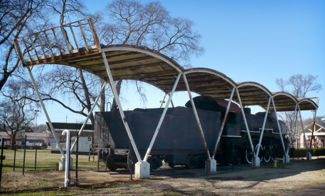Engine No. 4018
Engine No. 4018 is a Class USRA1 2-8-2 "Light Mikado" steam locomotive which operated for three decades hauling freight between Bessemer and Birmingham on the St Louis and San Francisco Railway. It went on display at the Alabama State Fairgrounds in 1952 and it is one of only a handful of locomotives of its type that survive.
Called a "war baby" because it was part of the build-up of cargo capacity ordered through the United States Railroad Administration during World War I, Engine No. 4018 was constructed in October 1919 to a standardized USRA design by the Lima Locomotive Works of Lima, Ohio for the Pennsylvania Railroad Company (order no. 20030). The coal-fired standard-gauge locomotive was capable of 54,700 pounds of tractive effort, running two 27" x 30" cylinders under 200 pounds per square inch of boiler pressure. The 2-8-2 designation refers to the arrangement of four driving axles (8 wheels) positioned between non-powered leading and trailing axles. The Mikado's driving wheels are 63 inches in diameter and its wheelbase is just over thirty-six feet. The overall length of the engine and its 10,000-gallon tender is just under eighty-two feet. The locomotive stands nineteen feet tall.
Engine No. 4018 was sold to the St Louis and San Francisco Railway in 1923 and spent much of the next three decades carrying transport between Bessemer and Birmingham. Steam engines were phased out in favor of diesel engines and No. 4018 was, in fact, the last steam locomotive to operate on any part of the Frisco Railway. The nickname "Mikado" took hold because a large order of American locomotives of this design were built for export to Japan's Nippon Railway in the 1880s, shortly after Gilbert and Sullivan's opera The Mikado had swept the nation. The name was sometimes shortened to "Mike", or, after the opening of hostilities in World War II, "MacArthur".
Retirement
At the request of then-Birmingham mayor Jimmy Morgan, the locomotive was saved from the scrap-yard and given a full overhaul before making its final five-mile run to Birmingham on February 29, 1952. Engineer Rufus Smith operated the engine with C. H. Stuteville as conductor, R. S. Blackburn and H. J. Parrish as brakemen, and Eli Wilson as fireman. A. M. Ball, assistant to Clark Hungerford, the President of the Frisco line, was in attendance for the occasion. It was formally donated to the city on May 29 of that year. A special spur was constructed to deliver it the selected spot near the Kiddieland amusement park at the fairgrounds, and a metal shed was built over it. Frisco employees were regularly sent over in the ensuing years to keep the engine in good condition.
Efforts to have the train moved to the Heart of Dixie Railroad Museum in the 1970s won the city's blessing, but were scuttled after objections from Burlington Northern, which had purchased a majority interest in the Frisco line.
In the late 1980s a cosmetic restoration was begun by a group of area railroad enthusiasts. The bell and headlight were removed for safe-keeping during the work, which involved sheet-metal patches over rusted areas and repainting. A new front coupler knuckle was donated and installed. The effort ran out of steam, however, and was never completed - partly for lack of security at the site. The bell and headlight remain in the possession of Chris E. Howard.
As the city of Birmingham planned a major redevelopment of Fair Park, Mountain Brook mayor Terry Oden headed efforts to plan its move to Sloss Furnaces National Historic Landmark and raising the estimated $150,000 needed to accomplish it. Oden is hopeful that additional funds will be donated to restore the massive locomotive.
Historic Machinery Services Corporation of Steele is coordinating the planned move, which will require lifting the 400,000-pound engine by crane to a trailer which can move it two blocks to the railway siding. It will then be lifted onto a flatcar for the trip to Sloss. The city of Birmingham and CraneWorks are contributing toward the operation.
A similar locomotive, No. 4003, located in Fort Smith, Arkansas has been nominated to the National Register of Historic Places [1].
References
- Stagner, Lloyd E. (1976) Steam Locomotives of the Frisco Line. Pruett Publishing Company. ISBN 0871080974
- Howard, Chris E. (n. d.) "Re: [ALrails] RE: Fw: [serails] RED ALERT !!!!!" posting to Alabama Railroads Yahoo! group. Reposted by Dale Burns to the Railway Preservation News forum (link)
- Thornton, William (January 12, 2009) "Mountain Brook mayor seeks donations to move 1917 locomotive." Birmingham News
External links
- St. Louis - San Francisco RR No. 4018 at steamlocomotive.info
- Engineering diagram of the USRA Light Mikado design published in the 1922 Locomotive Cyclopedia of American Practice at Wikimedia Commons
